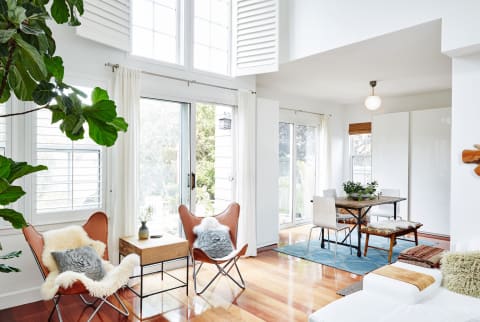Advertisement
4 Science-Backed Ways To Make Your Home Happier This Year


Our homes are one of the most underrated wellness tools at our disposal. Just consider all the ways that stepping into a clean, well-designed space can make us feel good—mind, body, and soul.
Lindsay T. Graham, Ph.D., at U.C. Berkeley's Center for the Built Environment is one academic researching why our homes have such an impact on us, and how we can design them to be as supportive as possible. Here, the personality and social psychologist shares four ways we can all get happy homes down to a science in the new year.
Welcome in more daylight.
In a recent collaboration with online interior design service Modsy, Graham analyzed survey data from over 1,500 people on how their home's design made them feel. While a lot of it came down to the individual, there were some home features that made people happy across the board. Natural daylight was one of them. This makes sense, Graham explains, because natural light is both appealing to the eye and it can help keep our circadian rhythms in check, supporting our mood and health overall in the process.
With this in mind, she recommends letting as much daylight into your space as possible or finding other ways to bring the outdoors in. There are countless ways to add touches of nature to your home, she tells mbg, so do whatever feels authentic and fun to you—whether it's starting a houseplant collection, showcasing natural materials, or designing with the color palette of your favorite landscape.
Express yourself with color.
As for some other interesting tidbits from the Modsy Interior Wellness Report: Rustic, contemporary, and Mediterranean were the styles that made people feel their happiest at home. Color also played a big role in how they perceived their spaces, with violet/purple, yellow, black, and green topping the happiness charts. Interestingly enough, the report notes that purple and yellow were not popular color choices—but the few people who did use them rated them very highly. This goes to show that using palettes that personally appeal to you, unconventional as they may be, can make your home feel more inviting.
Make it personal.
Graham says that one essential finding from her research overall is that one-size-fits-all home design does not exist. Instead, it's about going with what appeals to your unique needs and preferences—regardless of what's trendy or in vogue at the moment.
When designing your space for the year ahead, she recommends first getting clear on your goals: What you want to bring into your life, and what you're ready to let go of. From there, "think about what you can introduce—or eliminate—from your spaces to help support those goals," Graham says. For example, she says, someone who is craving more community can focus on optimizing spaces where guests can gather, arranging furniture so it cultivates conversation. Those who want to feel more joy can strategically place colors that make them happy in areas where they spend a lot of time. And anyone looking to eat more healthily can arrange their pantry so the most nutritious food is the easiest to access.
Get creative and upcycle.
How's this for a final unexpected tip: Graham says that making your home more sustainable can also support your mood and health in the long run. As more people start to adopt an environmental mindset, our homes can help us live in alignment with these new core values, she explains.
"There's also a physical health component to it," Graham adds, since higher-quality, eco-friendly designs often have a lower carbon footprint and chemical load. She says that shopping for secondhand furniture and upcycling used items are two ways to craft a more eco-friendly home—and have fun doing it: "When you allow yourself to expand your ideas of how something might be used, you are not only opening the door to sustainability, you're creating something unique."
If you do end up clearing anything out in the process, she says to look for ways to recycle, upcycle, or reuse it first.
The takeaway.
These four principles are just the starting point for your happy home—not the finish line. "At the end of the day," Graham points out, "none of our spaces are ever going to be 'perfect'—nor will they ever be totally 'done'. And they shouldn't be." Continuing to hone, refine, and switch up your space will lead to a home that's just as dynamic and lively as you are.